Auxiliary restraint system for airbags and seat belt tensioners (SRS)
Auxiliary restraint system (SRS) specifically designed to protect the driver and passenger from serious injury to the face and upper body in the event of a serious collision. Optimum protection can only be achieved when the system is used in combination with a traditional 3-point seat belt. The seat belts are an integral part of the SRS system.
SRS uses an ignition system powered by alternating current (AC).
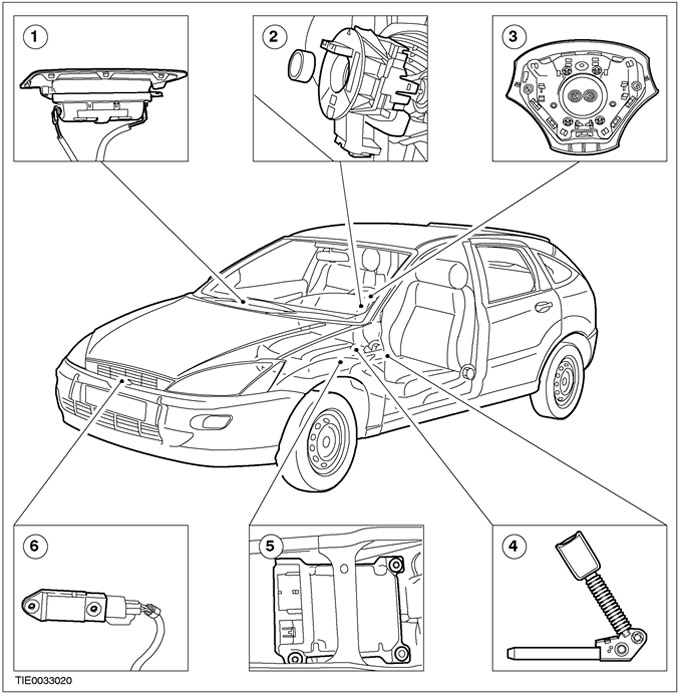
| Pos. | Spare Part No | Name |
| 1 | - | Passenger Airbag Module |
| 2 | - | clock spring |
| 3 | - | Driver Airbag Module |
| 4 | - | Seat belt buckle and pretensioner |
| 5 | - | Airbag control module |
| 6 | - | shock sensor |
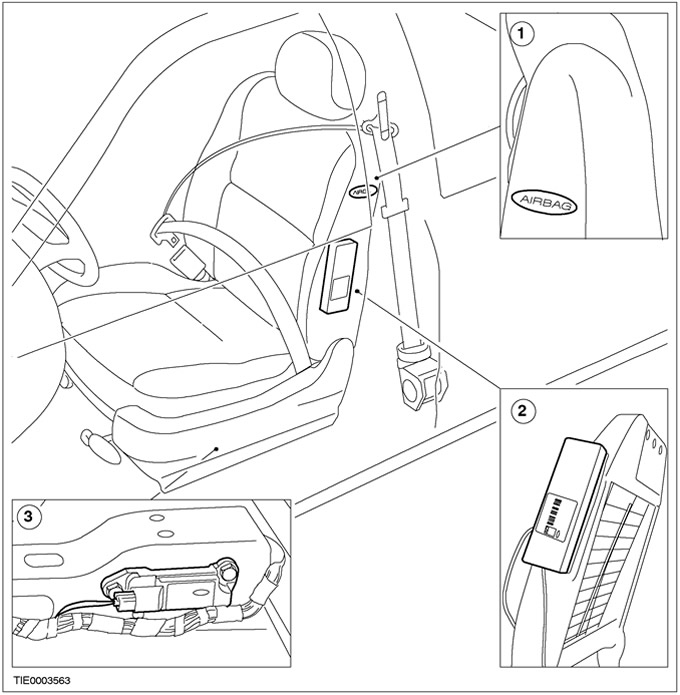
| Pos. | Spare Part No | Name |
| 1 | - | AIRBAG designation embossed on seat upholstery |
| 2 | - | Side airbag module |
| 3 | - | Side impact sensor |
The driver, wearing the standard seat belt, should position the seat as deep as possible so that the steering wheel is held with slightly bent arms. In this case, there must be free space between the steering wheel and the driver.
The front passenger using the seat belt must not be positioned in such a way that the airbag cover is in direct contact with the person's body.
The front airbags and seat belt pretensioners will deploy/deploy in the event of an impact greater than the deployment threshold, or in a direct frontal collision, or when the impact angle is up to 30 degrees to the left or right of the vehicle's centerline.
Pillow (And) seat belt pretensioners are single acting. In the event of an accident during which the airbag (And) safety belts and seat belt pretensioners deploy/deploy on the first impact, these features do not reduce the risk of injury in subsequent impacts.
In the event of a side impact in which the side airbags are deployed (in the presence of), the front airbags will still deploy in a subsequent frontal impact, provided that the force of the front impact exceeds the deployment threshold.
In certain situations, although the damage to the vehicle may look significant, the force of the impact may remain below the SRS threshold and the airbags will not deploy. In such situations, seat belts provide sufficient protection for the driver and passengers.
A visible VIN plate, showing the airbag symbol and X1, X2 or X4, depending on the number of airbags installed, is affixed to the edge of the instrument panel adjacent to the windshield.
The presence of side airbags in the vehicle configuration can be identified by the AIRBAG symbol embossed on the seat upholstery material next to the airbag module. There is a label attached to the B-pillar next to the seat.
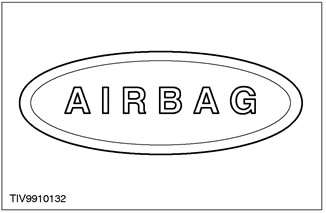
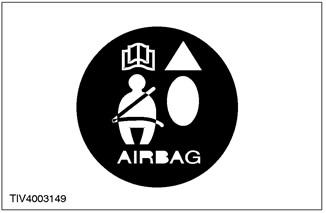
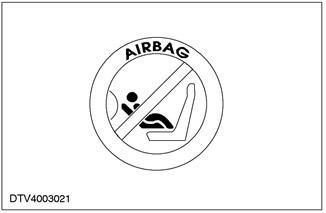
WARNING: All vehicles fitted with a front passenger airbag at assembly have a WARNING label on the instrument panel PROHIBITED use of a rear-facing child seat.
Under no circumstances will it be possible to deactivate the front passenger airbag while maintaining the integrity of the entire SRS system.
The SRS consists of the following elements:
- Airbag control module
- Dual-action front airbag modules
- Side airbag modules (in the presence of)
- Belt tensioners
- clock spring
- shock sensor
- Side impact sensors (in the presence of)
- Airbag warning lamp
Airbag control module
The airbag control module, located under the floor console, controls the operation of the entire system and performs continuous system diagnostics. Information about the force of the impact comes from the impact sensor and, in the event of a side impact, from the corresponding side impact sensor.
In the event of a frontal impact greater than a predetermined value, the airbag control module evaluates the signal received from the impact sensor and deploys the front airbag modules and deploys the front seat belt pretensioners, depending on the severity of the impact.
In the event of a side impact that exceeds a predetermined value, the airbag control module evaluates the signal received from the side impact sensors and deploys the appropriate side airbag module, depending on the nature of the impact.
In the event of a failure of the vehicle's power supply system during an accident, the airbag control module provides auxiliary power sufficient to deploy the airbag (ek) security, for a minimum of 150 ms. Vehicle battery power continuously provides auxiliary power to the airbag control module and maintains all other SRS functions when the ignition is in the 'RUN' position. If the airbag control module detects a malfunction, the airbag warning lamp comes on. The behavior of the warning lamp depends on the type of fault present.
After a collision in which the seat belt pretensioners or airbag deployed (ek) safety, a new airbag control module must be installed.
Dual-action front airbag modules
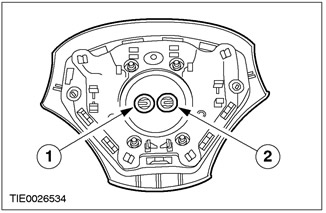
| Pos. | Spare Part No | Name |
| 1 | - | Driver airbag first stage electrical connector (black male connector) |
| 2 | - | Driver airbag 2nd stage electrical connector (green plug) |

| Pos. | Spare Part No | Name |
| 1 | - | Passenger airbag first stage electrical connector (green plug) |
| 2 | - | Passenger airbag 2nd stage electrical connector (pierces the plug) |
The driver's airbag module is mounted on the steering wheel, with its cover being the outer surface of the steering wheel pad. The cover has visible 'separation lines' molded into its surface which, when the system is deployed, allow the airbag to easily pass through the cover.
After deployment, a new driver airbag module and wiring harness with airbag module electrical connectors must be installed.
The passenger airbag module is located above the glove compartment and is attached to the vehicle's cross member and instrument panel. The passenger airbag has a visible flap to allow the passenger airbag to be easily deployed when the system is deployed.
Inspect the instrument panel for damage to the passenger airbag housing and install a new instrument panel if necessary after deployment.
After deployment, a new passenger airbag module and wiring harness with airbag module electrical connectors must be installed.
The driver and front passenger airbag modules each have two inflators.
In the event of a frontal impact greater than a predetermined amount, the airbag control module initiates the driver airbag module's first stage gas generator. The deployment of the second stage depends on the severity of the accident. As a result of evaluating these conditions, the second stage is deployed either 10 to 30 milliseconds or 100 milliseconds after the deployment of the first stage.
The airbag control module also triggers the first stage gas generator of the passenger airbag module. The deployment of the second stage depends on the severity of the accident. Based on the evaluation of these conditions, the second stage deploys either 20 to 30 milliseconds or 100 milliseconds after the first stage deploys.
Deployment after 100 milliseconds has little effect on airbag inflation but is used as a function «recycling» to eliminate the risk of subsequent tripping.
Side airbag modules
Side airbag (in the presence of) turns from the same side from which the impact sensor sent a signal to the airbag control module. Module (And) side airbags are integrated into the front seat backrests to provide a seamless appearance. The unique design of the seat upholstery allows for airbag deployment. When the side airbag is deployed, the seam in the seat upholstery adjacent to the side airbag module opens up, allowing the airbag to exit the seatback unhindered.
After deploying the side airbag, it is recommended to install a new seat.
When the pillow (And) The safety valve is deployed, it remains fully inflated for only a fraction of a second and immediately begins to deflate, dampening the impact on the person. The high boost rate, along with the accompanying events and impact noise, can give the impression that the airbag (And) security is not fully deployed.
The driver's airbag is a one-piece fabric, while the passenger's airbag and side airbags are sewn products. The airbags are silicone coated to provide protection from flames and heat in the vicinity of the gas generator. Shape of Passenger Airbag and Side Airbags (in the presence of) corresponds to the size of the car.
To prevent the folds of the airbag from sticking when it is in the folded position, the airbag material may be dusted with talcum powder. When the airbag is deployed (ek) The security part of the powder penetrates the car. This powder is perceived as a dust cloud and has a characteristic smell. The powder particles settle quickly and do not pose a health hazard. The dust cloud is not a sign of combustion outside of the airbag inflator.
Under certain circumstances, airbag deployment may result in minor scratches or minor friction burns.
There are two processes:
- Friction between the airbag material and exposed skin can occur either when the airbag deploys very quickly or when an occupant of the vehicle hits the airbag.
- The hot gases used to inflate the airbag are released when the airbag begins to deflate. Depending on the position of the driver's hands or how close the person is to the airbag, it is not always possible to exclude the possibility of contact of these gases with skin areas not covered by clothing.
Seat belt buckles and tensioners
Seat belt buckles and seat belt tensioners are installed on the seats. In the event of a front impact, the airbag control module will deploy the seat belt pretensioners. Seat belt tensioners have a lower deployment threshold than airbags. Therefore, with a minor impact, the force of which exceeds the threshold, it is possible that only the seat belt tensioners will be activated. The airbag control module receives information about the status of the seat belt buckles from switches located in the buckles. Refer to Section 501-20A / 501-20B for more information.
After operation, new locks and seat belt pretensioners must be installed.
Clock spring
The clock spring is used to transmit signals between the airbag control module and the driver's airbag module. The clock spring is mounted on the steering column and consists of a fixed and moving part, which are connected by twisted Moylar tape with integrated conductive tracks. Moylar tape can «unwind» And «curl up» as you turn the steering wheel (to which the movable part is attached), maintaining constant electrical contact between the airbag control module and the driver's airbag module.
It is recommended that the clock spring be replaced after the driver's airbag has been deployed.
Shock sensor
The front impact sensor is located under the panel with a hole for the grille, which facilitates the perception of impact along the longitudinal axis. The airbag control module processes the collision data sent by the front impact sensor and deploys the front airbag (And) security.
After a frontal collision, install new elements:
- if the seat belt tensioners and front airbag (ki) security guards fail/deploy, install a new panel with a grille hole if it is damaged.
- if the seat belt pretensioners deploy or the front airbag deploys (And) safety, a new shock sensor and a new panel with a hole for the grille should be installed.
Side impact sensors
Side impact sensors (in the presence of) located on the floor panel under the front seats, which makes it easier to perceive a side impact. In the event of a side impact, the airbag control module processes the impact data sent by the side impact sensor. The airbag control module, in the event of an impact greater than the deployment threshold, will deploy the side airbag on the side from which the deployment was initiated.
A new side impact sensor should be installed after a side impact in which the side airbag deploys.
Airbag warning lamp
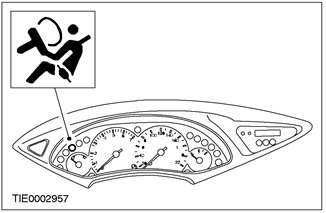
The airbag warning lamp is located on the instrument panel. In the event that the airbag control module detects a malfunction, the warning lamp flashes, flashes the corresponding fault code five times, and then remains on. For more information, see Chap. «Diagnostics and checks», presented in this section.
Visitor comments